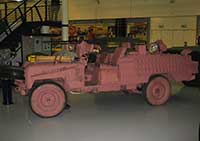Mobility Troop - SAS Land Rovers
Aside from the black counter-terrorism kit, one of the more iconic images of the Special Air Service is of bearded SAS troopers, dressed like Laurence of Arabia, driving gun-festooned jeeps across the desert.
During World War 2, David Stirling's SAS used American jeeps as their desert patrol and strike vehicles. In the post-war years the British-made Land Rover became the Regiment's favourite ride.
The armed Land Rover has gone through several developments throughout its history with the SAS.
Late 50s
For short range operations in Oman, Series I Land Rovers were stripped down and tooled up with twin vickers machine guns mounted on a raised commander's seat. A .30 cal machine gun was fitted facing rear and manned by the vehicle's radio operator. Series I Land Rovers had an 88-inch wheel base.
1967-1985
The need for a long-range platform resulted in the SAS adopting the Series IIA 90 Land Rover. With a wheelbase of 109 inches, the larger Series II could carry more stores and support longer range operations than its predecessor. The SAS painted their Land Rovers pink - not the most macho of paint schemes but one that was found to provide excellent camouflage in the desert. These 'Pink Panthers' or 'Pinkies' would serve the Regiment for nearly two decades. The Vickers and .30 cal machine guns were gradually phased out in favor of GPMGs and Browning .50 heavy machine guns.
1985-2014
In the mid-eighties the Land Rover 110 HCPU became the SAS's new Desert Patrol Vehicle (DPV). The DPV had coiled-spring suspension, providing for a much more comfortable ride than its predecessors. DPVs had a wheelbase of 110 inches and were powered by A 3.5 ltr V8 diesel.
SAS DPVs had mounts for an array of weapons and were configured in a number of ways:
- 1 x Commander's GPMG
1 x Rear GPMG - 1 x Commander's GPMG
2 x Rear GPMG - 1 x Commander's GPMG
1 x .50 cal HMG - 1 x Commander's GPMG
1 x Mk19 40mm grenade launcher - 1 x Commander's GPMG
Milan wire-guided missile launcher mounted on the DPV roll bars
The above is by no means an extensive list. The weapons mounted to SAS DPVs depended on the mission requirements and was limited by availability and the imagination of the wagon's crew. For instance, a DPV's driver might decide to mount a Minimi machine gun on his dashboard or the Milan wagon might have a GPMG fitted to cover the rear. Guns were attached to Vinghog softmounts.
It's been reported that the SAS experimented with other weapons systems for the DPV. These include a GIAT 20mm cannon, which proved unreliable, and a 7.62mm gatling gun which was highly effective but got through ammunition too quickly.
Aside from the various mounted weapons and the trooper's personal weapons, DPVs also carried :
- 84mm LAW anti-tank rockets
- M72 66mm rockets
- FIM-92 Stinger SAMs
- 81mm mortars
- bar mines - large slabs of exposives capable of flipping a tank - used to secure routes in to laying up areas
DPVs usually had their headlights and brake lights removed or disconnected to avoid accidental illumination at night. Smoke canister launchers were fitted to the front and rear of the wagons which could be fired to obscure the vehicle in event of a contact. Later modifications to the DPV platform included a full-length roll cage with a ring mount, similar to that found on WMIK Land Rovers.
A single DPV fits inside a Chinook helicopter and up to 4 can be transported inside a C-130 Hercules transport plane.
During their 20 years of service in 22 SAS, the DPV saw action in several conflicts:
- SAS DPVs were deployed to Saudi Arabia and driven north into the Iraqi Desert during Desert Storm by A and D Squadron. Whilst still affectionately called 'Pinkies' by the SAS, DPVs sported a more traditional beige camouflage scheme. During Desert Storm, some of the shorter wheelbased (92.9 inch) Land Rover 90s ('dinkies') in the SAS inventory were converted to 'gunships', with the addition of machine guns. These were put together for proposed B Squadron operations and were also used to protect a resupply convoy that the SAS drove into Iraq towards the end of operations.
- DPVs were also spotted by TV news crews operating in Sierra Leone, whilst the SAS were carrying out fact-finding missions in support of the UN.
- DPVs were used as a fire support platforms during a 2 squadron attack on an opium storage facility in Afghanistan, 2001 (Operation Trent)
- The SAS drove formations of DPVs from captured Iraqi air bases in western Iraq on search and destroy operations in the opening stages of Gulf War 2.
After a long and distinguished history with the Special Air Service, the Land Rover is now set to be replaced in the long range patrol / strike role by a yet to be determined model.









